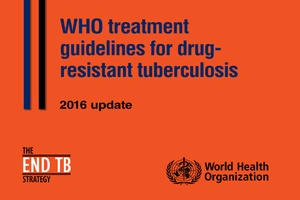World Health Organization recommends shorter treatment for multidrug-resistant TB
New World Health Organization recommendations aim to speed up detection and improve treatment outcomes for multidrug-resistant TB through use of a novel rapid diagnostic test and a shorter, cheaper treatment regimen.
12 MAY 2016 | GENEVA - New WHO recommendations aim to speed up detection and improve treatment outcomes for multidrug-resistant tuberculosis (MDR-TB) through use of a novel rapid diagnostic test and a shorter, cheaper treatment regimen.
“This is a critical step forward in tackling the MDR-TB public health crisis,” said Dr Mario Raviglione, Director of WHO’s Global TB Programme. “The new WHO recommendations offer hope to hundreds of thousands of MDR-TB patients who can now benefit from a test that quickly identifies eligibility for the shorter regimen, and then complete treatment in half the time and at nearly half the cost.”
Shorter treatment with better outcomes
At less than US$ 1000 per patient, the new treatment regimen can be completed in 9–12 months. Not only is it less expensive than current regimens, but it is also expected to improve outcomes and potentially decrease deaths due to better adherence to treatment and reduced loss to follow-up.
The conventional treatment regimens, which take 18–24 months to complete, yield low cure rates: just 50% on average globally. This is largely because patients find it very hard to keep taking second-line drugs, which can be quite toxic, for prolonged periods of time. They therefore often interrupt treatment or are lost to follow-up in health services.
The shorter regimen is recommended for patients diagnosed with uncomplicated MDR-TB, for example those individuals whose MDR-TB is not resistant to the most important drugs used to treat MDR-TB (fluoroquinolones and injectables), known as “second-line drugs”. It is also recommended for individuals who have not yet been treated with second line drugs.
WHO’s recommendations on the shorter regimens are based on initial programmatic studies involving 1200 patients with uncomplicated MDR-TB in 10 countries . WHO is urging researchers to complete ongoing randomised controlled clinical trials in order to strengthen the evidence base for use of this regimen.
Rapid diagnostic test to identify second-line drug resistance
The most reliable way to rule out resistance to second-line drugs is a newly recommended diagnostic test for use in national TB reference laboratories. The novel diagnostic test – called MTBDRsl – is a DNA-based test that identifies genetic mutations in MDR-TB strains, making them resistant to fluoroquinolones and injectable second-line TB drugs.
This test yields results in just 24-48 hours, down from the 3 months or longer currently required. The much faster turnaround time means that MDR-TB patients with additional resistance are not only diagnosed more quickly, but can quickly be placed on appropriate second-line regimens. WHO reports that fewer than 20% of the estimated 480 000 MDR-TB patients globally are currently being properly treated.
The MTBDRsl test is also a critical prerequisite for identifying MDR-TB patients who are eligible for the newly recommended shorter regimen, while avoiding placing patients who have resistance to second-line drugs on this regimen (which could fuel the development of extensively drug-resistant TB or XDR-TB).
“We hope that the faster diagnosis and shorter treatment will accelerate the much-needed global MDR-TB response,” said Dr Karin Weyer, Coordinator of Laboratories, Diagnostics and Drug Resistance, WHO Global TB Programme. “Anticipated cost-savings from the roll out of this regimen could be re-invested in MDR-TB services to enable more patients to be tested and retained on treatment.”
WHO is working closely with technical and funding partners to ensure adequate resources and support for the uptake of the rapid test and shorter, cheaper regimen in countries.
Quick facts
- Resistance to standard TB drugs exists in most countries worldwide. Drug resistance, fuelled by inadequate treatment, can spread through the air, from person to person, in the same way as drug-susceptible TB.
- Multidrug-resistant TB (MDR-TB) is caused by TB bacteria that are resistant to at least isoniazid and rifampicin, the two most effective TB drugs. Based on figures from 2014, the latest year for which data are available, WHO estimates that 5% of TB cases are multidrug-resistant. This translates into 480 000 cases and 190 000 deaths each year.
- Extensively drug-resistant TB (XDR-TB) is a form of MDR-TB that is also resistant to any fluoroquinolone and any of the second–line anti-TB injectable agents (i.e. amikacin, kanamycin or capreomycin). About 9% of MDR-TB patients develop XDR-TB, which is even more difficult to treat.
- The WHO "End TB Strategy", adopted by all WHO Member States, serves as a blueprint for countries to reduce TB incidence by 80% and TB deaths by 90%, and to eliminate catastrophic costs for TB-affected households by 2030.
MDR-TB regimen
- WHO treatment guidelines for drug-resistant tuberculosis - 2016 Update
pdf, 1.17Mb - Online Appendices
pdf, 1.81Mb - Frequently Asked Questions on the shorter MDR-TB regimens
pdf, 348kb
---------------------------------------
- Fact sheet on the shorter MDR-TB regimen
pdf, 497kb - Molecular line-probe assay for the detection of resistance to second-line anti-TB drugs (SL-LPA)
pdf, 448kb
Source: WHO


